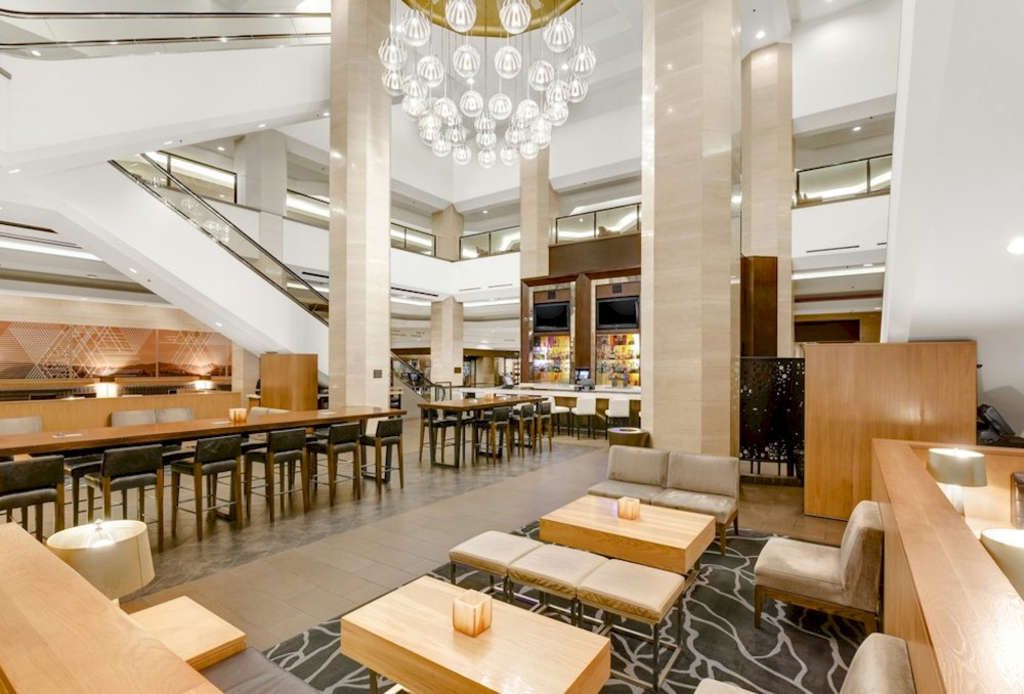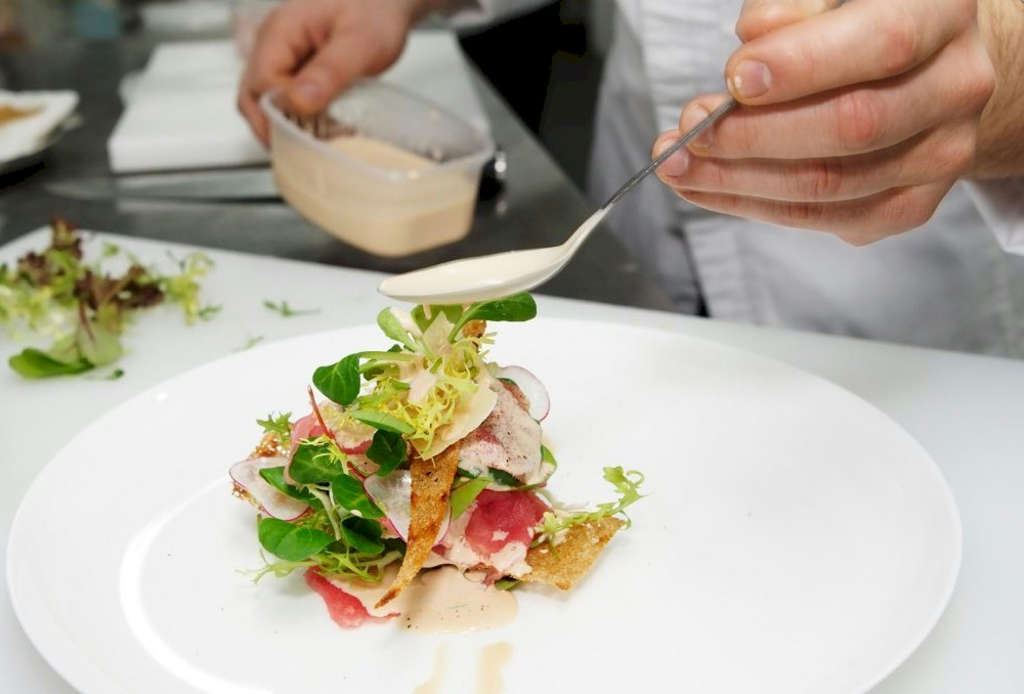By Kai Urban, Director of Food & Beverage, Hilton Anaheim
Key pillars of a profitable and successful hotel restaurant include enhancing guest experience while ensuring operational efficiencies. Hotel executives must navigate through the nuances of creating the right ambiance for the respective market and audience and address marketing, branding, and leveraging technology. To build and foster a stellar reputation as a hotel restaurant takes adapting to market trends and ultimately positioning itself as an indispensable asset in the competitive hospitality landscape.
Beyond the rooms, Hilton Anaheim is known for an array of amenities and multiple dining options that tantalize taste buds with diverse cuisines, while recreational facilities like fitness centers and swimming pools cater to guests seeking relaxation or rejuvenation after a day of Disney adventures. At the heart of the hotel is the MIX Restaurant & MIX Lounge where guests can enjoy a happy hour cocktail, breakfast Mickey Mouse waffles, shrimp tacos for lunch, and white bass for dinner.
For Hilton Anaheim, the MIX Restaurant & MIX Lounge, and food & beverage program, is a key component of the property and has become pivotal to positioning Hilton Anaheim as a destination. Creating a hotel restaurant like MIX that stands apart from the competition wasn’t developed overnight, but with clear direction and goals in mind, a hotel restaurant can become a coveted amenity to not only transform guests’ experiences but also drive sales to increase profitability.
MIX Lounge — Photo by Hilton
Enhancing Guest Experience and Convenience
A hotel restaurant plays an integral role in enhancing the overall guest experience. It offers a convenient dining option right on the premises, which is particularly appealing after a day filled with travel, meetings, or exploring. This convenience factor, coupled with the ability to cater to a diverse range of dining preferences and dietary needs, adds a significant layer of personalization and comfort to the guest experience. Whether catering to business travelers, vacationing families, or solo adventurers, a hotel restaurant can adapt its offerings to meet the varied demands of its guests. Moreover, hotel restaurants serve as cultural touchpoints. They offer guests a taste of the local cuisine and ingredients, thus enriching the travel experience and forging a stronger connection with the destination. This aspect of local engagement elevates the dining experience from a mere meal to an immersive cultural exploration.
For those visiting Hilton Anaheim, located walking distance from Disneyland Resort and next door to the Anaheim Convention Center, MIX caters to both the family and working professionals, providing convenience and enhancing the guest experience for every type of traveler. For example, MIX Restaurant offers Mickey waffles, which anchor Hilton Anaheim to one of Anaheim’s biggest draws – Disneyland – and offers guests visiting the amusement park a special experience at the hotel. For business travelers, MIX Lounge is the perfect locale for after-convention cocktails with the team. This attention to detail and catering to the property’s demographics helps Hilton Anaheim’s food & beverage offerings stand out from the competition in the area.
Driving Revenue and Profitability
From a business perspective, an on-site restaurant can be a revenue-generating asset for a hotel. Hilton Anaheim MIX Restaurant & Lounge continuously brings in hotel guests day in and day out for breakfast, happy hour cocktails, and more. For its Thanksgiving buffet, over 150 guests were reserved ahead of time and the speciality menu proved to be a strong revenue driver. F&B directors ought to consider holiday buffets to increase profits as a way to bring in guests around the holidays to dine conveniently.
Beyond just attracting hotel guests, a hotel restaurant can draw in local residents and other visitors, contributing significantly to the hotel’s bottom line. Additionally, a well-regarded hotel restaurant can become a deciding factor for potential guests choosing their accommodation, thus indirectly boosting room sales. Guests often show a preference for hotels that offer high-quality on-site dining options, seeing them as adding value to their overall stay.
Understanding the Market and Audience
One of the first steps in creating a profitable and successful hotel restaurant is to understand the market and audience. For Hilton Anaheim, our proximity to Disneyland Park & Resorts and the Anaheim Convention Center presents a unique mix of families, business travelers, and convention attendees. This diverse clientele demands a versatile dining concept that can cater to varied preferences and occasions – from a quick breakfast to a leisurely dinner or a business lunch. Due to the proximity to Disneyland Park & Resorts and the large number of families that stay at the hotel, the Mickey Mouse waffle at the MIX Restaurant became a huge selling point for parents looking for breakfast options. Hotel executives ought to consider the various demographics, including children, international tourists, and business travelers.
Culinary Excellence as a Cornerstone
At the heart of a successful hotel restaurant is its culinary offerings. It’s essential to strike a balance between appealing to a broad audience and offering something unique. Our approach involves a menu that celebrates local produce, honors regional flavors, and occasionally features an innovative twist on familiar dishes. Executive Chef Juan Lopez, at the helm of our MIX Restaurant, infuses his Mexican heritage and a commitment to sustainable sourcing into his culinary creations. This not only elevates the dining experience but also resonates with guests looking for authentic, responsibly sourced meals.
Innovation is crucial within the hotel restaurant to maintain interest and avoid falling behind the other culinary offerings within the city/market where the hotel is located. Successful hotel restaurant executives should consider themed dining experiences, chef-driven events, seasonal menus, and more to keep the offerings fresh and engaging. Embracing culinary trends while staying true to the restaurant’s identity, such as offering specialty cocktails, unique pairings, or interactive cooking classes, can add that extra spark, making the restaurant a talking point among guests.
MIX Restaurant — Photo by Hilton
Creating the Right Ambiance
Ambiance plays a pivotal role in defining a restaurant’s character. It’s about creating an environment that complements the dining experience – whether it’s a casual setting for families or a sophisticated space for business dinners. The design, lighting, and decor of the MIX Restaurant are carefully curated to offer a warm and inviting atmosphere, aligning with the overall aesthetic and values of the Hilton brand. The most important part of this aspect is the harmony between the space and the intended experience, ensuring that guests feel comfortable, engaged, and transported to a world tailored to the occasion.
The Pool Bar & Grill at Hilton Anaheim, for example, is a seasonal space open in the summer months, that borders the hotel’s pool and kid’s Splash Zone, and offers outdoor seating for those who are looking for a more casual, alfresco setting. One must consider the previously mentioned components, the market, the audience, and the menu when considering what would be the best ambiance for the hotel restaurant.
Operational Efficiency and Staff Excellence
Operational efficiency is crucial in managing costs and ensuring profitability. This includes everything from kitchen layout and equipment to inventory management and staff scheduling. Equally important is staff training and development. A well-trained, knowledgeable, and courteous staff can significantly enhance the guest experience, encouraging repeat visits and positive word-of-mouth.
Consistency in every aspect-from the taste and presentation of dishes to the attentiveness of the staff-is paramount. A hotel restaurant’s ability to replicate excellence day after day, ensuring that each guest encounter mirrors the same high standards, is what defines its reliability and credibility. The most important part of this consistency is the meticulous attention to detail-no matter the time of day, the volume of guests, or the complexity of orders, maintaining excellence is non-negotiable.
Marketing and Branding
A well-crafted marketing strategy is critical in creating buzz and attracting patrons. This involves leveraging various channels – from social media and digital marketing to local partnerships and events. At Hilton Anaheim, we focus on storytelling through our marketing efforts, highlighting our culinary philosophy, showcasing our chef’s creations, and promoting special offers and events.?
Adapting to Market Trends
The industry isn’t without its challenges. Supply chain disruptions, economic uncertainties, and shifting consumer behavior, especially post-pandemic, have posed hurdles. Nevertheless, these challenges have birthed innovations. Technology adoption, streamlined delivery services, and creative marketing strategies have been instrumental in navigating these turbulent waters. The hospitality and culinary worlds are ever-evolving. Staying attuned to market trends – from dietary preferences to dining styles – and adapting accordingly is vital. This doesn’t mean chasing every trend but thoughtfully incorporating elements that align with your brand and audience.
Operating a restaurant within a hotel is a multifaceted endeavor, requiring adept management, careful navigation, and constant adaptation. Amidst the allure of culinary creativity and hospitality, several struggles persist, shaping the day-to-day operations and strategic decisions in this dynamic setting. Managing demand fluctuations presents a consistent hurdle. Hotel restaurants are subject to seasonal variations, event-driven traffic, and unpredictable guest flow. Peaks and troughs in occupancy directly impact restaurant traffic, requiring agile planning to ensure optimal staffing levels, inventory management, and service readiness.
Creating Experiences Beyond Dining
Finally, a hotel restaurant should offer more than just good food. It’s about creating memorable experiences – be it through themed dining nights, cooking classes, or chef’s table events. At Hilton Anaheim, we continually explore ways to add value to the dining experience, making each visit unique and memorable.
Reprinted from the Hotel Business Review with permission from http://www.hotelexecutive.com/.




